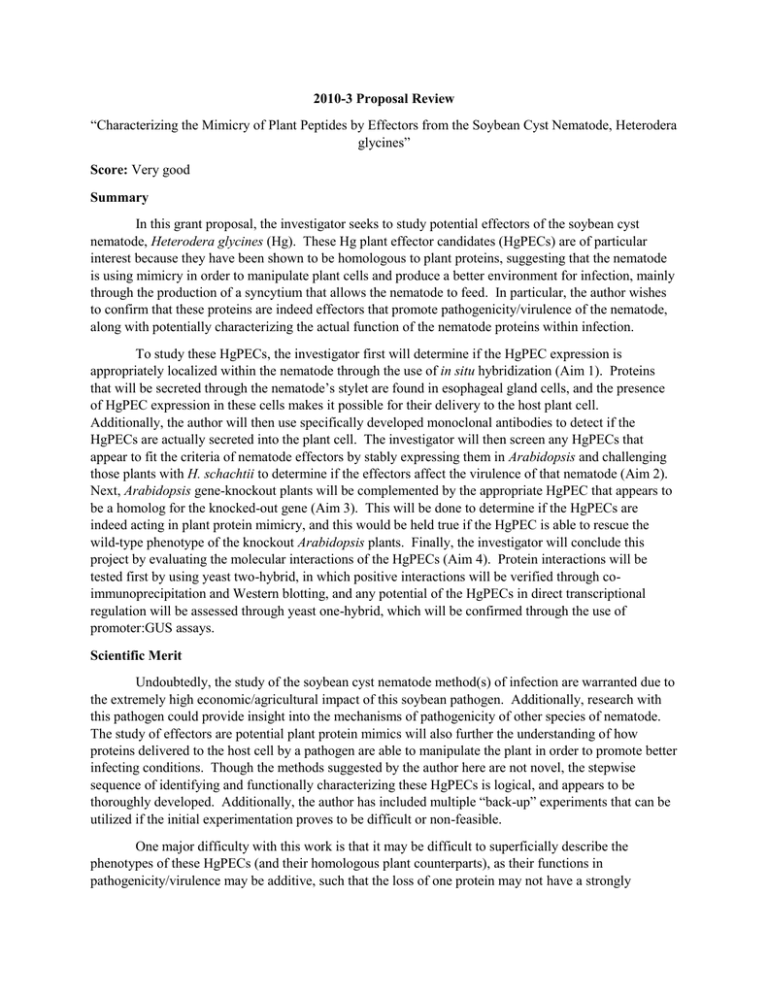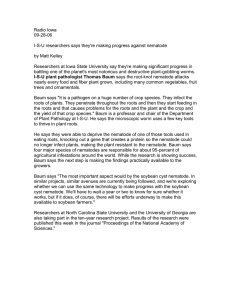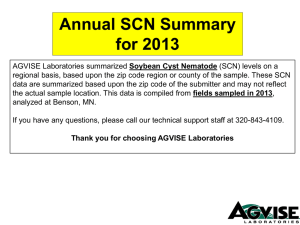2010-3 Proposal Review
advertisement

2010-3 Proposal Review “Characterizing the Mimicry of Plant Peptides by Effectors from the Soybean Cyst Nematode, Heterodera glycines” Score: Very good Summary In this grant proposal, the investigator seeks to study potential effectors of the soybean cyst nematode, Heterodera glycines (Hg). These Hg plant effector candidates (HgPECs) are of particular interest because they have been shown to be homologous to plant proteins, suggesting that the nematode is using mimicry in order to manipulate plant cells and produce a better environment for infection, mainly through the production of a syncytium that allows the nematode to feed. In particular, the author wishes to confirm that these proteins are indeed effectors that promote pathogenicity/virulence of the nematode, along with potentially characterizing the actual function of the nematode proteins within infection. To study these HgPECs, the investigator first will determine if the HgPEC expression is appropriately localized within the nematode through the use of in situ hybridization (Aim 1). Proteins that will be secreted through the nematode’s stylet are found in esophageal gland cells, and the presence of HgPEC expression in these cells makes it possible for their delivery to the host plant cell. Additionally, the author will then use specifically developed monoclonal antibodies to detect if the HgPECs are actually secreted into the plant cell. The investigator will then screen any HgPECs that appear to fit the criteria of nematode effectors by stably expressing them in Arabidopsis and challenging those plants with H. schachtii to determine if the effectors affect the virulence of that nematode (Aim 2). Next, Arabidopsis gene-knockout plants will be complemented by the appropriate HgPEC that appears to be a homolog for the knocked-out gene (Aim 3). This will be done to determine if the HgPECs are indeed acting in plant protein mimicry, and this would be held true if the HgPEC is able to rescue the wild-type phenotype of the knockout Arabidopsis plants. Finally, the investigator will conclude this project by evaluating the molecular interactions of the HgPECs (Aim 4). Protein interactions will be tested first by using yeast two-hybrid, in which positive interactions will be verified through coimmunoprecipitation and Western blotting, and any potential of the HgPECs in direct transcriptional regulation will be assessed through yeast one-hybrid, which will be confirmed through the use of promoter:GUS assays. Scientific Merit Undoubtedly, the study of the soybean cyst nematode method(s) of infection are warranted due to the extremely high economic/agricultural impact of this soybean pathogen. Additionally, research with this pathogen could provide insight into the mechanisms of pathogenicity of other species of nematode. The study of effectors are potential plant protein mimics will also further the understanding of how proteins delivered to the host cell by a pathogen are able to manipulate the plant in order to promote better infecting conditions. Though the methods suggested by the author here are not novel, the stepwise sequence of identifying and functionally characterizing these HgPECs is logical, and appears to be thoroughly developed. Additionally, the author has included multiple “back-up” experiments that can be utilized if the initial experimentation proves to be difficult or non-feasible. One major difficulty with this work is that it may be difficult to superficially describe the phenotypes of these HgPECs (and their homologous plant counterparts), as their functions in pathogenicity/virulence may be additive, such that the loss of one protein may not have a strongly noticeable effect. In particular, the author wishes to complement Arabidopsis knockout plants (with knockouts pertaining to the homologs of the HgPECs). Though this has been shown to be a potentially successfully method there may be several issues. First, as suggested above, the Arabidopsis mutant may not have a noticeable physical phenotype, and the infections of H. schachtii may not be noticeably affected if the effector only has a subtle role in infection. Additionally, though it is acknowledged by the author, these HgPECs, while homologous to proteins found in Arabidopsis and Oryza sativa (rice), are used in nematode infection of soybean. While the homologous proteins may also be found in soybean, there is the possibility that the HgPECs will not be functional, or will have reduced functionality within the Arabidopsis system. Though soybean transformation may be difficult, it may be worth looking in to if the Arabidopsis system does not seem to be fruitful. Broader Impact As mentioned above, this work could have a very broad impact on the plant pathology field, as soybean cyst nematode is an extremely relevant pathogen of soybean. Furthermore, the study of their effectors could give insight into means by which nematodes are able to successfully infect their host plants, and may even be applicable to the use of effectors by pathogens in other systems. The thorough approach laid out by the investigator suggests that these effectors will be studied in great enough depth that future studies will be able to be carried out that perhaps look at individual HgPECs in much greater detail in order to tease out their complete function in nematode infection (29 potential effectors is probably too many to be intricately characterized within the work of this proposal). While a potential setback is the use of Arabidopsis in evaluating the role of these HgPECs in planta, if this approach turns out to be successful, then the effectors in question could have a strong potential to be a common means of pathogenicity for many different nematodes that infect different species of plant, and it is not outside the realm of possibility that other pathogens may attempt to manipulate the same/similar pathways in order to increase their own pathogenicity/virulence. Conclusions Overall, I felt that this proposal was very well written and contains sufficient depth to be considered for funding. While there may be a few issues experimentally that may have prevented a higher score, the investigator appears to have thought through many of these problems and has provided a number of secondary experiments that could be performed if the initial experiments fail. The author seems to have good direction and focus, and their train of thought emphasizes their expertise in the subject matter.




